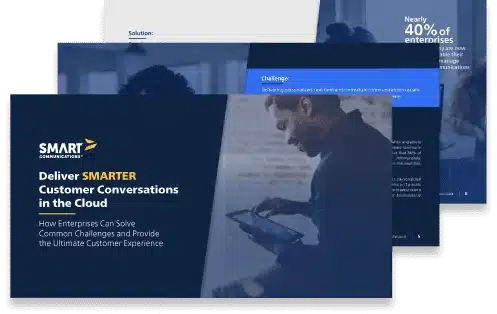Optimize Digital Forms for COVID-19 Claims
By: John Zimmerer, VP Healthcare Marketing at Smart Communications
Per the Biden administration’s recent announcement, beginning Jan. 15, 2022, nearly all U.S. private health insurance plans must cover at least a portion of the cost of up to eight at-home COVID-19 tests per month for their members. While the federal government and public health officials have been discussing how to make at-home tests more accessible for some time, the specifics of the rollout were unclear until recently.
There are several conditions in the proclamation, however. For example, not all COVID-19 tests are covered, and not all insurers are required to cover the cost of the tests. There are two types of tests –rapid antigen-based and molecular-based (PCR) – so there are two lists of FDA-approved test kits. A 12-page FAQ defines the insurers covered under the mandate. As the pandemic continues to evolve, we can also expect the government’s expectations and requirements of insurers to change as well. This is putting more pressure on health insurers than ever to scale processes in a way that allows them to be more agile and efficient.
Needless to say, insurers had some homework to do to ensure they could comply with the new mandate. Five days was not much time to put processes and communications in place to handle what will no doubt be many claims for reimbursement. Unfortunately, the current claims experience is relying heavily on manual, paper-based processes. The good news? There is a better way.
In this post, we highlight how health insurers can rethink the claims submission experience, plus why COVID-19 has shed a light on the need for digital forms transformation.
Background Information
To be reimbursed for COVID-19 at-home tests purchased after Jan. 15, plan members are required to file a claims with their insurance plan. The majority of the coronavirus resource websites we have seen include instructions to download and print a COVID-19 Over-the-Counter (OTC) Test Kit Claims Form.
With this current process, these reimbursements are most likely going to be painful for both the payers and their members. But, a digital forms solution – which can be implemented quickly – can make this experience much more seamless.
Filling Out the Claims Form
Current State:
Even large, national health insurers are posting claims forms that were created in Microsoft Word. While it’s impressive what a determined designer can create in Microsoft Word, a claims form shouldn’t be one of those things. These documents are clearly intended from the start to be printed and filled out with pen and paper.
It makes little sense to start with a digital Microsoft Word file saved as a Portable Document Format (PDF) that a member must access with a digital device, only to have the member print out the form and thereby convert a somewhat digital process to analog, via ink and paper. If a member needs a device to access the form, why can’t they use a device to fill it out? Even a fillable PDF form would be better for all involved, as it would at least remove legibility as a potential barrier to processing the form.
Then there is the sheer number of fields that must be considered and potentially completed on these forms – we have seen at least one claim form that had nearly 100 fields! Common form fields include requesting information about the test kit(s) purchased, primary customer, patient and coverage, as well as several attestations and a certification as to the authenticity and accuracy of the information being provided.
By our estimate, the insurer that had posted this form already has 50 to70% of this information.
Desired Future State:
Investing in digital forms transformation for COVID-19 related claims allows health insurers to easily implement an intelligent, guided experience while also connecting to systems of record to pull in existing data for the member to review and (optionally) update. The remaining required information could be reduced to a few clicks with a series of simple yes/no questions and checkboxes.
Submitting the Claims Form
Current State:
Most insurers are asking members to mail or fax the completed reimbursement form. There are three big problems with these outdated submission methods:
- No confirmation for the member that the form was ever received by the insurer.
- The information on the form is not secure in transit.
- It creates the opportunity for the member to forget to attach the receipt.
Yes, one could pay extra to add tracking to the mailed form, however we can assume few people will go through the effort given the relatively low dollar amount of each reimbursement (up to $12 per individual test).
Some might say that a fax machine will tell the member whether the transmission was successful, and that is true. But what if the member mistakenly dialed the wrong fax number? This poses security concerns for personally identifiable and/or protected health information. What if the insurer uses a fax server? The member will never know until the reimbursement check shows up that the right department received the form. With faxing, there’s likely to be an interim step – copying the receipt onto a standard-sized sheet of paper so it will fax better. This wastes the member’s time and money and increases the risk that the receipt will not be legible. Besides, how many members in 2022 have easy access to a fax machine?
Desired Future State:
Cloud-native, digital forms solutions are accessible using any internet-connected device via a web browser. They leverage device capabilities like cameras for taking pictures of receipts, which can be attached electronically. Digitizing the end-to-end process eliminates handwriting and handling.
Processing the Claims Forms
Current State:
When relying entirely on physical forms, the chances of a large number of submissions being Not in Good Order (NIGO) are high. Potential errors or issues include a skipped a field, illegible handwriting, a forgotten receipt, a missing signature, date and more. We estimate that at least 10% of forms will be rejected for some reason other than the purchase was made prior to the start of the program.
Consider this: All the forms submitted via fax or mail will need to be (re)digitized and then run through optical character recognition (OCR) software. No OCR package claims accuracy greater than 99% on a page level (so 990 out of 1,000 characters will be correct), and that’s with typed characters; research has shown that the accuracy often drops for handwritten or photocopied material.
If the average COVID-19 test claims form has 100 fields and if the average field has five characters (FYI, the average email address is 21.9 characters long and the average last name in the U.S. is more than five characters), then at least five characters will be incorrect on every form processed. Will it be the transaction details, rendering the form useless? Will it be the member’s name, rendering the check null and void? Or will it be the mailing address, rendering the check undeliverable?
Desired Future State:
Digital forms for COVID-19 related claims allow health plans to use business logic to ensure that forms are in good order prior to a member submitting. They can integrate with e-signature solutions, thereby negating the need for printing, mailing or faxing anything to the payer. And, these solutions can generate PDF documents so the member has a record of what was submitted, and the insurer has something that can be provided to an auditor or a regulator if required.
Where to Go from Here
The implications of COVID-19 have shed a light on the need for digital forms transformation. As the course of the pandemic continues to change, so too will state and local governments, public health officials and health insurers’ responses. In such a fast-moving climate, it’s more important than ever to have sophisticated, cloud-based technologies that enable health plans to be innovative, agile and efficient.
When faced with all the areas in healthcare that are ripe for transformation, it can feel overwhelming to decide where to start. At Smart Communications, we believe in identifying certain processes that can be transformed quickly and provide near-immediate results. Investing in forms transformation is a key step in modernizing healthcare and optimizing the end-to-end member experience.
Beyond collecting information and checking boxes, redefining how information is gathered means health insurers can respond quickly and via preferred channels – a critical component of every stage within the member experience. Intelligent interviews modernize the collection and use of member information, empower members to initiate conversations with their health plans and remove friction from critical interactions.
—
SmartIQ from Smart Communications is a low-code form automation and digital process software that takes manual form processes and reimagines them—turning one-way, disjointed form processes into innovative, two-way interactions that expedite processing times and create experiences customers appreciate. To learn more about how SmartIQ enhances digital forms for COVID-19 related claims, check out our ebook 5 Ways Health Insurers Can Reimagine Forms.



